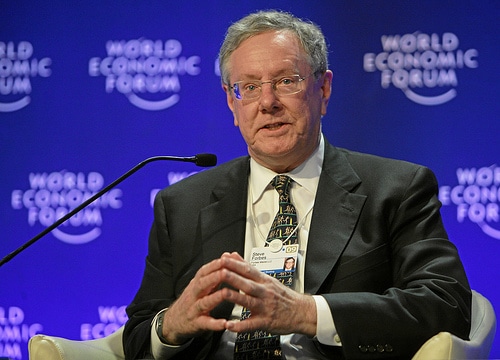
Despite wrapping its separate Forbes.com business into the mothership in 2009 after nearly a decade, Forbes Media’s top executives insist the magazine and website fulfill distinct destinies, as evidenced by the launch of a new print magazine edition today aimed at 20,000 European executives.
“Print allows you to deal in a story in a much more thorough way, initially, than you do online,” chairman Steve Forbes said during a press briefing this morning. “Online then allows you to amplify things like the lists, to get more information – which gives you the grist to do perhaps another print story. Each of these platforms is different but each has its own unique characteristics for conveying information.”
In Europe, the publisher aims to grow its roster of 12 informal online contributors to almost 30 this year to serve the continent which gives nearly two million of Forbes.com’s 19.7 million monthly uniques. Local staff additions will be fewer.
Forbes.com was started as a separate business in 2000. New group CEO Mike Perlis today said it was formed “as a startup”. But it was recently folded in with the magazine enterprise as online CEO Jim Spanfeller left. “Integrating it in to the whole is really important now in terms of service to readers and opportunities to advertisers,” Perlis said – but specifics on reasons for absorbing Forbes.com weren’t offered.
Steve Forbes added: “When we started Forbes.com, we physically put it in another building. They reported to me and my brother, not through the normal chain of command – otherwise, it would have been treated as an ancillary product and it would never have been able to grow. When the baby became an adolescent, then we merged them together again.”
Despite being absorbed, the website is by no means a replica of the magazine – it comprises blog posts and articles written by an informal network of contributors. “We’re creating a social journalism environment with not a one-way but a two-way, three-way, four-way dialogue with people in the marketplace,” Perlis said, perhaps with a degree of hyperbole. “We’ve built a platform that’s based on contributors, whether it’s a staff writer or consumer. Each contributor has a set of tools – all mesh in to one enormous social network of content.”
So why launch in print at all? Chief revenue officer Kevin Gentzel explained a survey informed the decision: “We found they still turn to the printed word as well as magazines frequently to make better business decisions. Our magazine readership has probably never been bigger than it has over the last year. Advertising in to print is really starting to pick up.”
The group is cross-selling ads across the two media, of course – but is now trying to sell online space differently, Steve Forbes said: “There was a tendency, to be blunt, five years ago, to do online marketing the way we did in print – CPM very high, buy the whole magazine (audience). But, if you break out unique (audience) segments, it can work. (Advertisers) will pay a premium and not the two cents per thousand if you try and do it as one-size-fits-all.”
Full of forecasts about the state and future of the global economy and U.S. politics, Steve Forbes told journalists gathered around his breakfast table: “If it’s any consolation, what happened to the media is going to happen to every other industry. Believe me, the tornado of the internet is going to hit everything.”